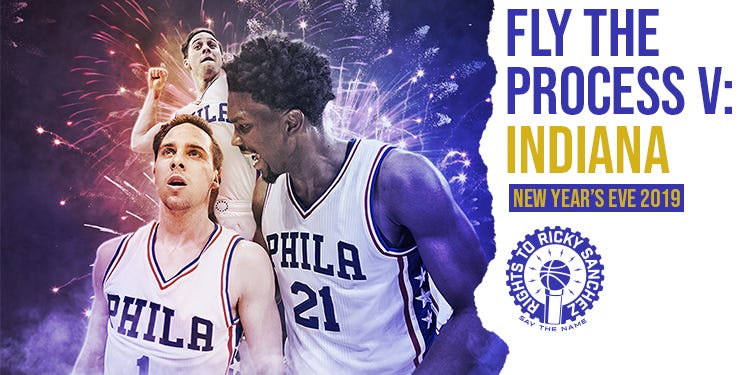Brett Brown Has Been the Sixers' Closer This Season
The closer doesn’t even wear a uniform.
Andrew Unterberger is a famous writer who invented the nickname 'Sauce Castillo' and is now writing for The Rights To Ricky Sanchez, as part of the 'If Not, Pick Will Convey As Two Second-Rounders' section of the site. You can follow Andrew on Twitter @AUGetoffmygold and can also read him at Billboard.
Andrew's writing is brought to you by Kinetic Skateboarding! Not only the Ricky's approved skate shop, but the best place to get Chucks, Vans, any apparel. Use code "DAVESILVER" for 9.1% off your order.
When Jimmy Butler and J.J. Redick left the Philadelphia 76ers’ fold this summer, two questions plagued the remainder of their offseason: Who would provide perimeter shooting, and who would take over at the end of games? Through the Sixers’ first ten games, the answer to that first question is more of a SCENE MISSING than ever. Furkan Korkmaz has been brilliant but seems due to remember that gravity exists any game now, and meanwhile, our starting five’s ostensible two best shooters have been a combined 23-95 (!!?!?) from three, and you-know-who might have decided to end his shooting career from beyond on a high note this pre-season.
But we might have found our answer to the second question. We’ve got our closer, and his name is Brett Brown.
Not the name most of us would have predicted going into the season, obviously. Most of us pictured final Sixers positions ending with Tobias Harris fancypantsing his way into long top-of-the-key jumpers, or Josh Richardson hurtling around screens for contested elbow looks, or Joel Embiid backing down his defender in the post until there was no more down to back. Maybe those of the more optimistic Process Trusters among us even envisioned Ben Simmons electing to take his defender off the dribble. None seemed particularly optimal as go-tos, but they appeared to be the best choices we had.
Turns out we had another option, and it’s a 58-year-old with a Bostralian accent, a magic marker and a vision. Brett Brown has done what Sixers fans long believed impossible after spending the better part of a decade of watching Andre Iguodala, Lou Williams and Evan Turner calling for a clear out as the game clock dwindled: He’s actually drawn-up late-game plays. And they’ve worked: Of the Sixers’ seven wins so far this season, three of them were on go-ahead scores from brilliant final-minute Brett calls -- and there should’ve been a fourth.
Brett Brown has run some great ATOs at the end of games this year: Hi-lo for Embiid against Atlanta, Korkmaz game-winner against Portland, Harris-Embiid hi-lo there against Cleveland. The last play against Denver got negated by a bogus foul but Embiid had the seal.
— Rich Hofmann (@rich_hofmann) November 13, 2019
The first call, against Atlanta, was the most basic design: With the score tied at 103-103 and seven seconds to go, Brown had Richardson and Harris run to opposite ends of the three-point line, while Horford looked to be setting a pick to spring Harris but really popped out to the top of the arc to take Simmons’ in-bound pass. Harris, Richardson and Horford all dragged their man well clear of the paint, where Embiid was tussling solo with Hawks big John Collins for position. Embiid got the inside seal on Collins, Horford delivered the perfect entry pass, and the swarming Hawks were forced to foul JoJo for the go-ahead free throws. Simple but effective.
The next one, against Portland, was a quick-hit beaut. Down two with two seconds to go, the action was built around the basic misdirection of no one really expecting that the final play would be drawn up for Furkan Korkmaz -- then still with the reputation of a mere mortal, not the fire-breathing, dick-kicking dragontaur we know him as today. The play appeared designed for Tobias Harris heading towards the rim or Al Horford drifting to the three-point line, but instead Horford smothered a surprised Damian Lillard with his ample bosom while Kork darted around the screen for an open corner three. I still can’t get over how much room he had when he caught the pass.
But Tuesday night’s winner against Cleveland was the true masterpiece. Down one with 20 seconds to go, Richardson took the ball from 35 feet out as Embiid set up for a screen at the three-point line. He nailed Richardson’s man (Kevin Porter Jr.) perfectly, but instead of rolling hard to the hoop or popping out for a jumper as might be expected, he positioned for a pindown on Harris’ man (Larry Nance Jr.) as Tobias sprung out to the free-throw line for a feed from J-Rich. Then when Harris got the ball, JoJo curled around Nance for the inside seal, Tobi tossed the perfect pass over the top of the defense, and Embiid dunked home an uncontested two. I really don’t think I’m exaggerating when I say this is the most perfectly designed and executed late-game play I’ve ever seen -- certainly from the Sixers, maybe from anyone.
And yeah, you can throw the Nuggets game -- down one with just a second left -- on this pile, too. This was the same concept as the Atlanta play, designed for getting Embiid an unobstructed one-on-one against his man in the post, with Joel already having secured the inside position. Embiid got to his spot, the rest of the Sixers gave him room to maneuver, and Richardson lobbed it to where only Jo could get it, seemingly leading to an easy buzzer-beating deuce -- but the refs whistled Embiid for the push-off on defender Nikola Jokic, and the ball went back to Denver. (The league later deemed that it should’ve been a foul on Jokic, btw.)
Of course, I don’t want to diminish the role that, y’know, the actual players had in making these game-winning plays. They all rely on five guys executing their roles to perfection, and any one slight mishap -- an errant Simmons in-bounds, a weak Horford screen, a miscalibrated Harris entry, a too-aggressive Embiid seal, or of course, a slightly flat Korkmaz jumper -- and each of the plays disintegrates. To a certain extent, that’s why so many NBA teams rely on one-on-one hero ball late in games: When you have a guy who excels at taking his man off the dribble and creating something on his own, it’s much simpler than designing a Rube Goldberg machine that takes 27 separate actions just to spit out a basket.
But the Sixers don’t have that. What they have is a deep roster of smart pros with size and strength advantages to leverage. It’s not something we’ve seen a ton of across Sixers squads past, but it makes all the sense of the world that the team would try to draw up late-game plays that use compound actions to put their guys in the best spot possible to get an easy bucket -- rather than just flipping the ball to Harris, Richardson or Embiid and saying God Bless. We don’t need another hero. We need Brett Brown and his staff of trained whiteboard assassins to conjure up the X-and-O magic that leaves opposing defenses slumping their shoulders, pointing at each other like Yeah But I Thought You Were Gonna. And through ten games, that is exactly what we’ve gotten.
Is it a sustainable plan for the whole season -- or, for that matter, the postseason? Do Brown & Co. have enough tricks up their majestically tailored sleeves to keep up this standard of late-game razzle-dazzle, or will defenses eventually start sniffing out the Sixers’ misdirections and force them to do a little improvising? We’ll see, but we’ve already gotten farther than we ever have before with our late-game execution relying on our man with the plan to carry us through. Set your watches: The fourth quarter is now officially Brett Time.



![[photo: @Sixers] [photo: @Sixers]](https://substackcdn.com/image/fetch/$s_!23UG!,w_1456,c_limit,f_auto,q_auto:good,fl_progressive:steep/https%3A%2F%2Fsubstack-post-media.s3.amazonaws.com%2Fpublic%2Fimages%2Fa1482288-08a4-445f-9a65-de451f619898_1623x811.jpeg)


